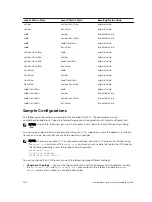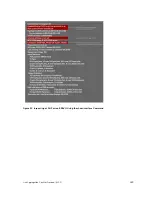
• There is a difference between the
shutdown
and
no interface port-channel
commands:
– The
shutdown
command on LAG “xyz” disables the LAG and retains the user commands.
However, the system does not allow the channel number “xyz” to be statically created.
– The
no interface port-channel
channel-number
command deletes the specified LAG,
including a dynamically created LAG. This command removes all LACP-specific commands on the
member interfaces. The interfaces are restored to a state that is ready to be configured.
NOTE: There is no configuration on the interface because that condition is required for an
interface to be part of a LAG.
• You can configure link dampening on individual members of a LAG.
• You can configure a maximum of 128 port-channels with up to 16 members per channel.
LACP Modes
Dell Networking OS provides three modes for configuration of LACP — Off, Active, and Passive.
•
Off
— In this state, an interface is not capable of being part of a dynamic LAG. LACP does not run on
any port that is configured to be in this state.
•
Active
— In this state, the interface is said to be in the “active negotiating state.” LACP runs on any link
that is configured to be in this state. A port in Active state also automatically initiates negotiations with
other ports by initiating LACP packets.
•
Passive
— In this state, the interface is not in an active negotiating state, but LACP runs on the link. A
port in Passive state also responds to negotiation requests (from ports in Active state). Ports in Passive
state respond to LACP packets.
Dell Networking OS supports LAGs in the following cases:
• A port in Active state can set up a port channel (LAG) with another port in Active state.
• A port in Active state can set up a LAG with another port in Passive state.
A port in Passive state cannot set up a LAG with another port in Passive state.
Configuring LACP Commands
If you configure aggregated ports with compatible LACP modes (Off, Active, Passive), LACP can
automatically link them, as defined in IEEE 802.3, Section 43.
To configure LACP, use the following commands.
• Configure the system priority.
CONFIGURATION mode
[no] lacp system-priority
priority-value
The range is from 1 to 65535 (the higher the number, the lower the priority).
The default is
32768
.
• Enable or disable LACP on any LAN port.
INTERFACE mode
[no] port-channel-protocol lacp
The default is
LACP disabled
.
This command creates context.
428
Link Aggregation Control Protocol (LACP)
Содержание Z9000
Страница 1: ...Dell Configuration Guide for the Z9000 System 9 7 0 0 ...
Страница 80: ...grub reboot 80 Management ...
Страница 128: ... 0 Te 1 1 Te 1 2 rx Flow N A N A 128 Access Control Lists ACLs ...
Страница 436: ...Figure 50 Inspecting Configuration of LAG 10 on ALPHA 436 Link Aggregation Control Protocol LACP ...
Страница 439: ...Figure 52 Inspecting a LAG Port on BRAVO Using the show interface Command Link Aggregation Control Protocol LACP 439 ...
Страница 440: ...Figure 53 Inspecting LAG 10 Using the show interfaces port channel Command 440 Link Aggregation Control Protocol LACP ...
Страница 491: ...Figure 70 Configuring OSPF and BGP for MSDP Multicast Source Discovery Protocol MSDP 491 ...
Страница 492: ...Figure 71 Configuring PIM in Multiple Routing Domains 492 Multicast Source Discovery Protocol MSDP ...
Страница 496: ...Figure 73 MSDP Default Peer Scenario 1 496 Multicast Source Discovery Protocol MSDP ...
Страница 497: ...Figure 74 MSDP Default Peer Scenario 2 Multicast Source Discovery Protocol MSDP 497 ...
Страница 498: ...Figure 75 MSDP Default Peer Scenario 3 498 Multicast Source Discovery Protocol MSDP ...
Страница 760: ...Figure 100 Single and Double Tag TPID Match 760 Service Provider Bridging ...
Страница 761: ...Figure 101 Single and Double Tag First byte TPID Match Service Provider Bridging 761 ...






























